M/Cing to SA: Bolivia, briefly
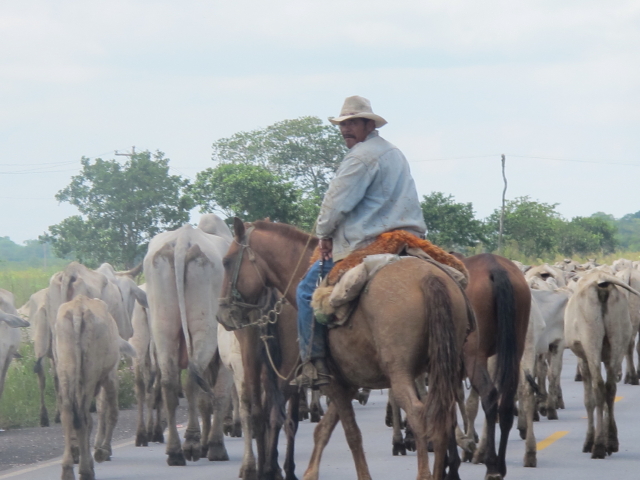
Follow me! And we did. We encounter a couple of hundred brahma bulls on Bolivian Ruta 4. We follow a cowboy closely to thread our way through the herd. By this time, potentially getting stomped by a ranging brahma bull didn’t seem so out of place.
Eleven days in Bolivia are simultaneously too much and not enough
We never gave Bolivia much of a chance to impress, though it certainly did. La Paz during Carnival is wild. Cochabamba is a rocking town. The mountains between Cochabamba and Santa Cruz reminded us of the Sierras. Dropping down from the Altiplano into the lush tropical jungle was like heaven. Miles and miles of jungle split by an almost perfect piece of asphalt makes for unique motoring. And the people, oh the people, they were terrific: curious, helpful, and warm.
Yet, we know we didn’t see Bolivia at its best. We couldn’t make it to the Salar de Uyuni because the rains washed out the roads. We didn’t have the time to go into the Bolivian Amazon or to really explore La Paz and Santa Cruz. We never even made it to Sucre and Petosi, reportedly two of its most interesting cities. And, some of the scenery is a blur as we motored through it with haste.
We never found all the things we were warned about. Overwhelming poverty? Poor yes, but India’s level of poverty, no. Terrible, impassable roads? Most were pretty good, considering the HUGE amount of rain Bolivia just received. Crime? No, we just lost one camera stolen out of our hotel room in Santa Cruz. We never felt afraid on the streets. Political protests blocking the road. Huh? Bolivians and Peruvians take their politicking seriously, so there were frequent rallies in the cities.
So, just eleven days after entering Bolivia, we leave it for Brazil. Too short, for sure. But powerful none the less. My strongest memories will be…
- The visual shock of seeing La Paz for the first time spread out below us as we enter via the Autopista. Its size, its redness, and the way it just fills the mountains and hills. Breathtaking.
- Riding right into the middle of Carnival 2011! On a Saturday night and into the neighborhood for partying. Crazy.
- Anxiously awaiting the fresh rolls for breakfast at our hotel in La Paz. The only hotel we’ve encountered where one of the girls picked up fresh rolls on her way to work every day. She was inevitably late : )
- The dim, bleak hotel in Oruro. No Wi-Fi, no Internet, five cable stations, and depressed attitudes. We beat it out of there post haste.
- The cold, beauty and rain of more than 30 days on the Altiplano (both Peru and Bolivia). All the time spent at 10,000+ feet, most of the time at 12.5, and at least a half-dozen times at 13-14K. Clear, crisp, green and cold. Rain at 38 degrees is ruthless. I don’t think KR and I ever got warm the entire time we were up there. Not being able to sleep as a byproduct was the pits as well. But pretty, and oh so green.
- Cochabamba! A three night stay in the finest hotel we’ve been in since Santiago. A rocking middle class. Another Carnival celebration complete with street parades. And really nice folks at Masters BMW who worked all day on servicing Now Voyager. Cochabamba was great.
- The mind-boggling change that occurs in the course of an hour as we ride over, and then down, the mountains going south from Cochabamba toward Santa Cruz. All of a sudden, we’re in the tropics! 80 degrees. Jungle vegetation. Houses built on stilts because of water and various animals. Eastern Bolivia is a vast jungle.
- One of the best moments of the trip: sitting on the curb under the canopy of the only gas station that was working west of Santa Cruz. KR is looking at The Book (Footprint’s South America Handbook) trying to find us a place to stay in Santa Cruz. We’re tired, but have a coke and beer. Then the sky opens up with a monsoon style rain storm. We sit there “safe” and watch the rain crash down and about. Of course, twenty minutes later we had to ride into this storm, but we felt safe for a few minutes beforehand. An admittedly weird great moment.
- Being on Now Voyager, running straight and fast east on Bolivian Ruta 4. The road is so smooth because its perfect cement. KR comes over the intercom and say, “Wow, stress free riding!” Five minutes later the road ends abruptly with a hand painted detour sign. This commences a two hour fight down a dirt road connecting the western and eastern part of Ruta 4. The most stressFUL riding we’ve been in 🙂
- Making our own coffee in a restaurant in Carmen. The proprietor also sold us some gasoline. We sat there and made coffee and somehow communicated with Johnnie and took photos of him and his kids.
- The last 200+ miles to the Brasilian border on Ruta 4. Cement smooth, fast, and the landscape was stunning. Had to hold NV back at 85.
Riding with risk
When you’re flying along, running fast and smooth, one has a lot of time to think. Any motorcyclist knows what I mean when some of my clearest thinking occurs at these times. Seventy-five days on the road is a long time to be riding a motorcycle (for most people! for some reading this this post, it’s just a short stint).
Both KR and I are tired. Strangely, not from the physical effort, which is much, much more than I remember. Nor from the hassle of packing and unpacking everyday. We’ve got that down to easy to assemble modules. Nor is it from the few really scary situations we’ve been in. Or the sometimes very long days in the saddle.
No, we both agree that most of the weariness comes from not knowing something(s) key about the day ahead. (Note: this is not a complaint as its also the source of much of the thrills). Most days, we don’t know at least one of the following:
- Where we’re going the next day? Week? Month?
- How far the next night’s stop is
- How do we get there? What route will be best?
- What’s the road condition. Is it passable?
- What’s the weather going to be like? How much rain will we get?
- Where we’re staying
- Will we have enough gas and will the gas stations be operating
- Where do we get local currency when we need it
- Some part or aspect of NV is questionable and needs attention. Will I — or whomever — be able to fix it?
- How much is this all going to cost? How are we going to pay?
There have probably only been a handful of days in the past seventy-five that haven’t had a mixed collection of the above. Sometimes they’re really minor and just take up a small amount of our “worrying capacity.” Others consume our attention for days at end. Should we take the “New Road” from Cochabamba to Santa Cruz? The bridge is supposedly out. Or, maybe the “Old Road” is passable now? It’s longer, but maybe we can get trough…
Once again, none of this is a complaint. This is exactly what KR and I signed up for. If we wanted it any other way, we would have signed up for a tour. Yet, there ARE days that a tour sounds pretty damn good 🙂
Another note about logistics: money
It’s true that one can go through much of South America on an ATM card as cash machines are in most decent-sized towns. The best offer both local currency or dollars. Yet, a couple of notes of caution here. First, your ATM card will not work with all cash machines — especially in Bolivia. If your ATM card is a Visa bank card, most of the ATMs won’t work. Secondly, ATMs are scarce when one really needs cash — small towns. Most establishments only take cash. This is especially true of gas stations. Only hotels in sizable towns take credit cards.
Dollars are a decently traded currency in Argentina, Peru and Bolivia. They are the only currency Border crossings take from Norte Americanos. Chilians won’t take a dollar even if you wanted to just it to them as a present. For that reason, I would always recommend keeping a stash of dollars with you as a fallback position.
Exchange rates and bank charges vary widely and its difficult to decipher how much you’re getting f___ed. For example, hotels and such apply a really low currency exchange rate (low as in lower # of their local currency to each dollar) if you ask how much something costs in dollars. But they always charge your credit card with the local currency, which means your credit card institution is the ultimate decider of the exchange rate. I’ve found that they’re usually much better than local cambios and this advantage often offsets their 3% “international transaction” fee. Same principle applies to ATM machine commissions, which are charged in local currencies.
And aside from exchange rates, what do things cost? Varies greatly by country. Most expensive is Chile, then Argentina, Peru and finally Bolivia. We just entered Brasil, but I’m afraid it will be on the top of this list. Hotel rooms in Peru and Bolivia are $30-$40. In Argentina, $50-$75. Chile you can easily spend $75 and we were hit for $160 in Santiago. Also depends on whether you’re in-season or not (evidently, we were in season in Chile and the off season in Peru). Wine is consistenly cheap. Food can be, but we got screwed with really expenisve meals in Chile a couple of times. We unknowingly spent $55 for lunch in one out-of-the-way Chiliean resort. And it was horrible: )
Gas? Between changing currencies and converting litres to gallons, I don’t have the slightest. But, gas won’t be a budget buster on a bike anyway. I miss the Altiplano where I got great gas mileage enabling us to go more than 300 miles with all our on-board gas. Down at sea level, I’m lucky to get 200+.
Here are the videos
We shot some more amateur-hour video while in Bolivia. Sorry, most of its on the road. And I still haven’t figured out how to adjust the camera’s brightness settings.
#1. Bolivian mountain road: Deep in the heart of South America we discover… pine trees and the Sierras!
#2. 26 miles of dirt: A clip on riding in mud and dirt of a Ruta 4 detour. Although it was just 26 miles, it took us a full two-hours to get through. Both KR and I thanked our lucky stars that it hadn’t rained for a day or two, or we would not have made it
#3. FW comments on 26 miles of dirt: Look closely and you can see my riding partner give me the thumbs up with a different finger.
#4. Welcome to New Mexico — not! KR and FW riding on Ruta 4
#5. FW in the middle of the jungle and New Mexico: Ruta 4 is ever changing
#6. Ruta 4 at speed. The Bolivians have spread miles and miles of glass-smooth concrete on Ruta 4
Here are the pictures
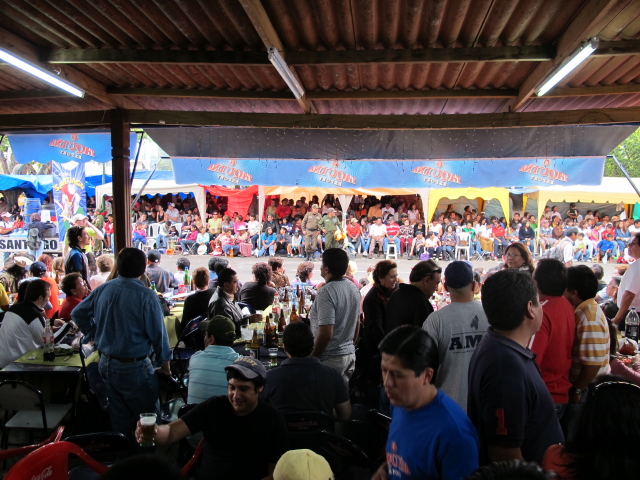
Wherever we go,there’s a party. One week to the day after experiencing Carnival in La Paz, we experience Carnival in Cochabamba. This time we spend an afternoon watching the parades and celebrations jammed in with all the Cochabamba(ians). Great people watching.
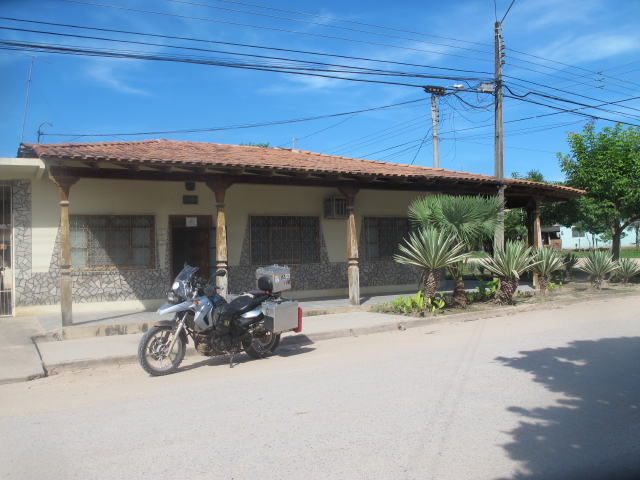
Quick, what does this look like? Whatever your answer, it’s wrong. You’re looking at the Brazilian Consulate’s office in Puerto Suarez, Bolivia. Tough to find in a town of dirt roads and no road signs. Tough to get them to do anything in real time. The problem? We couldn’t purchase Brazilian visas at the border. Sammy Hershfield told us this two weeks beforehand, but we ignored his sage advice.
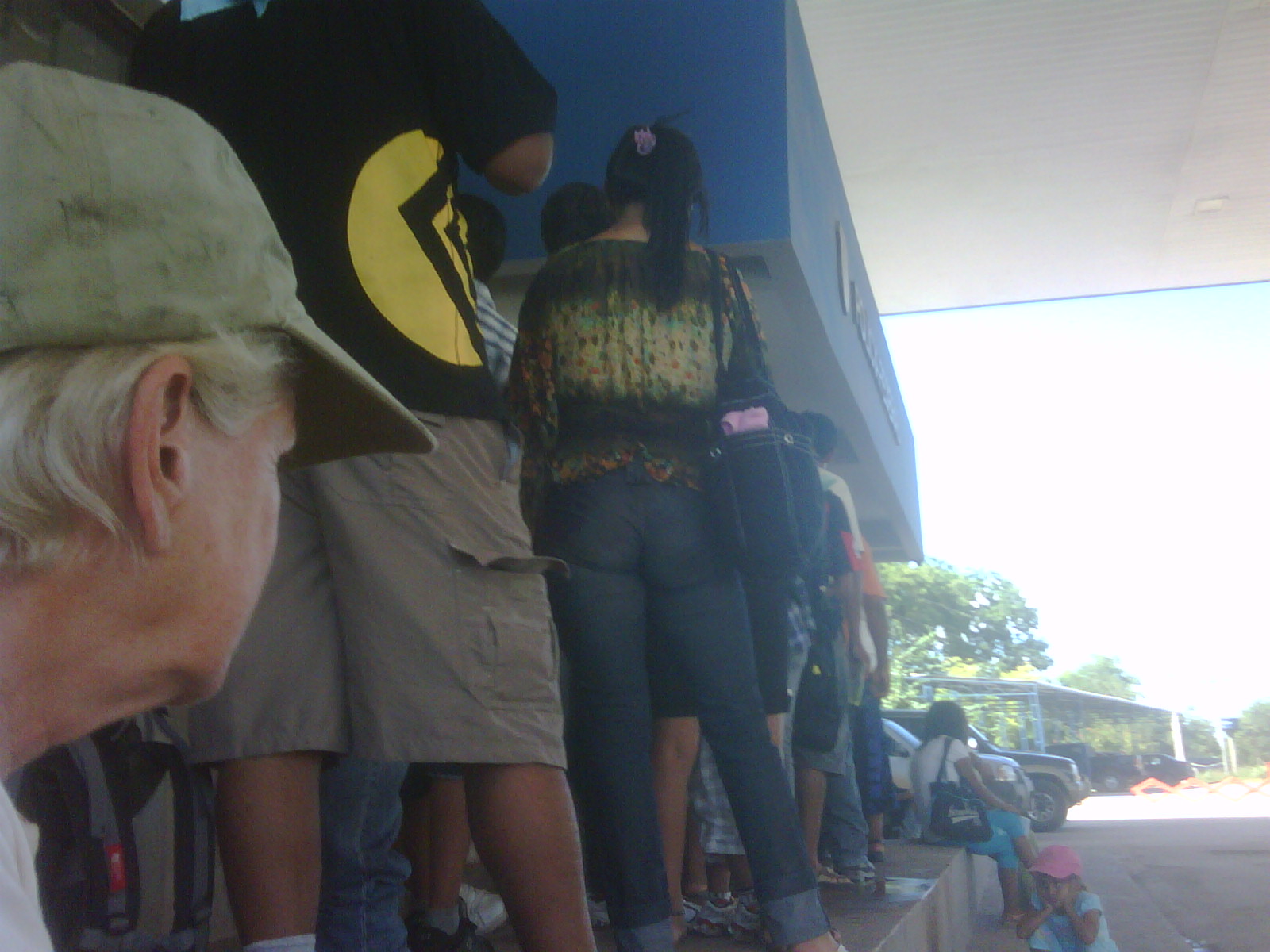
It took us a total of 27 hours to get through the border. Here, KR waits in the Brazilian Immigration line.
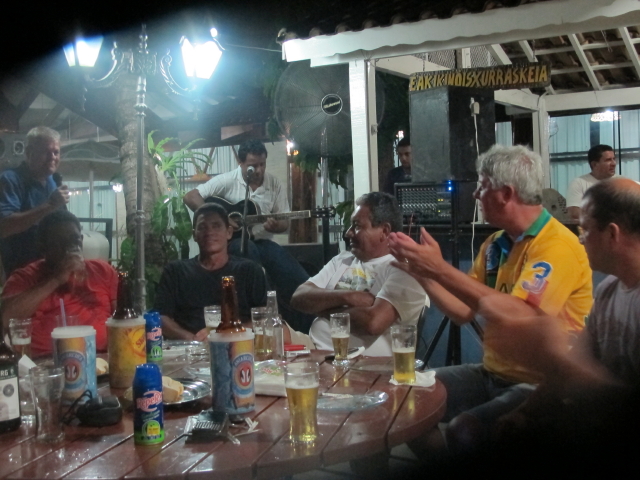
I told you wherever we go, a party follows. First night in Brazil and we crash a party of friends and relatives on a three day fishing vacation. All welcomed us warmly and we danced, sang, ate and drank together like we were old time buddies. Very, very nice people. Only one person spoke English. We’re beginning to realize that Portuguese is going to be a real foreign language…

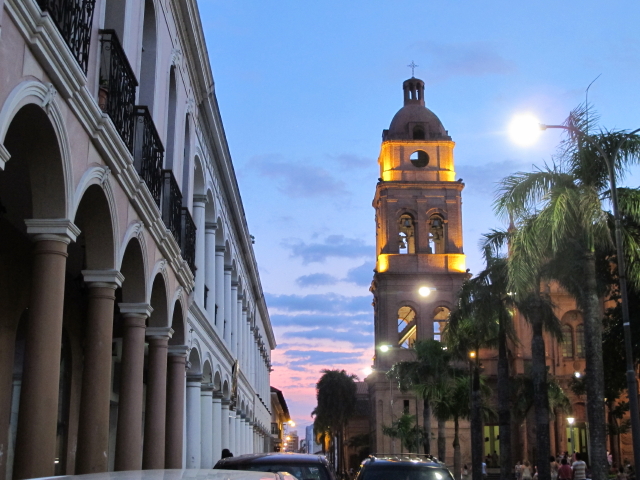

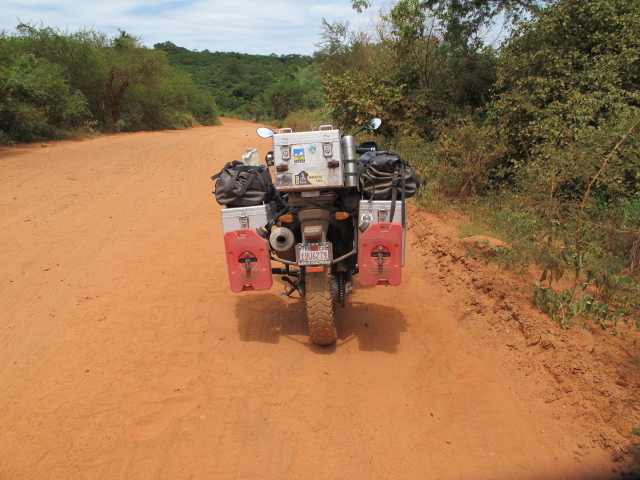
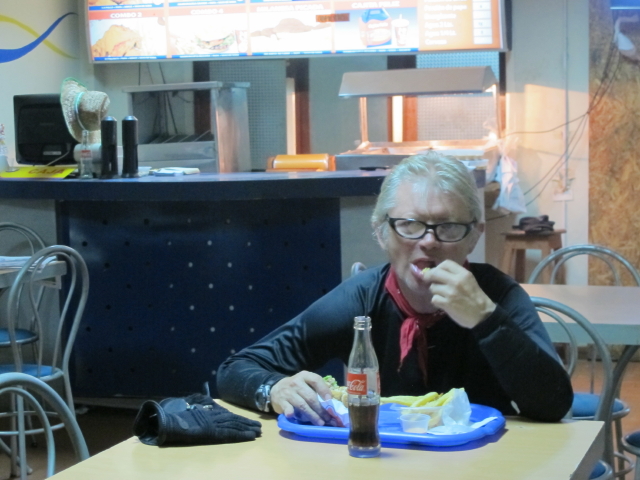
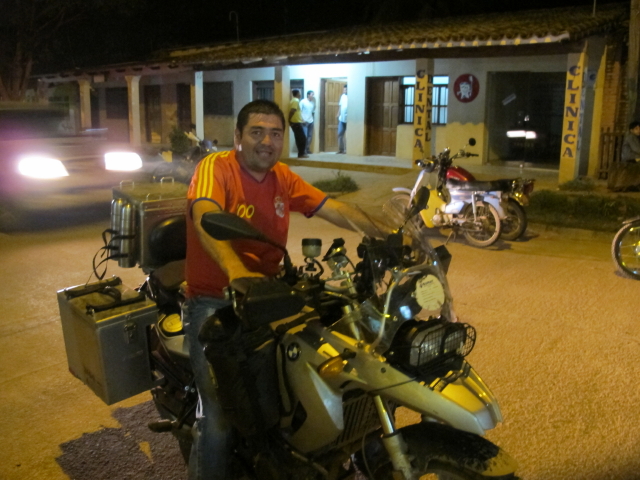
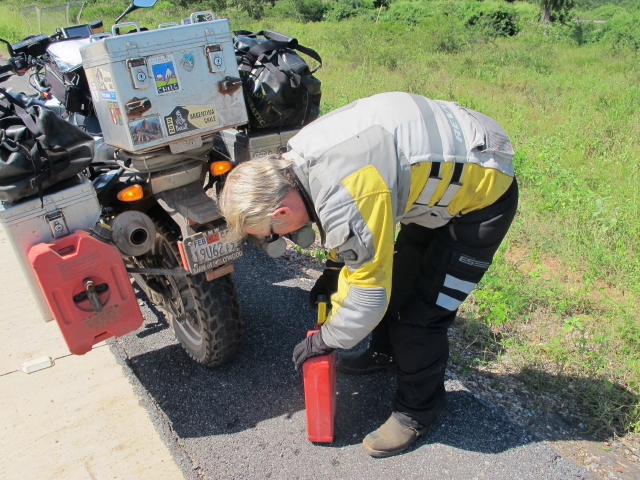
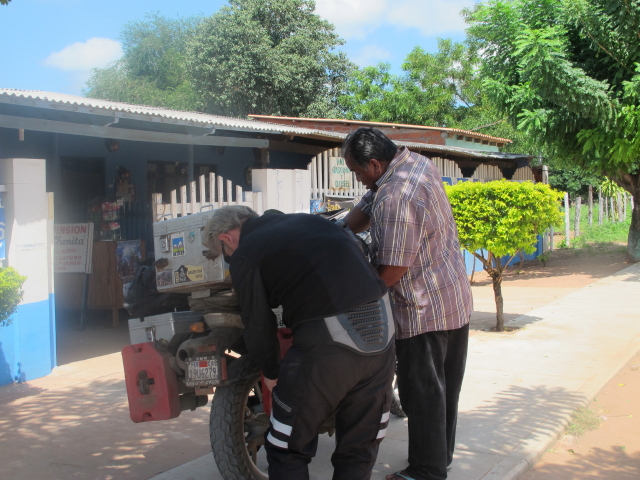


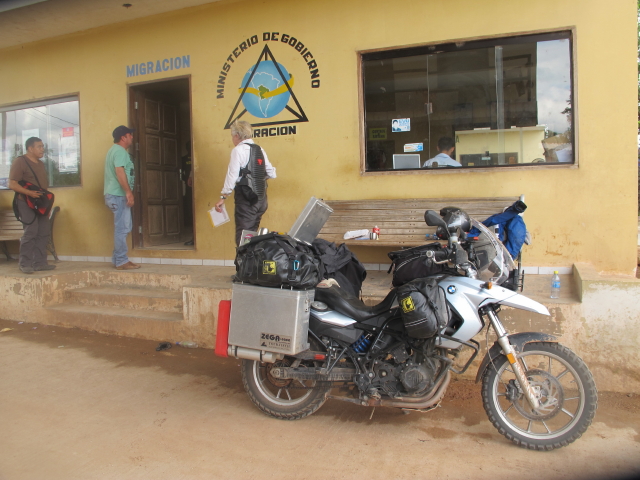
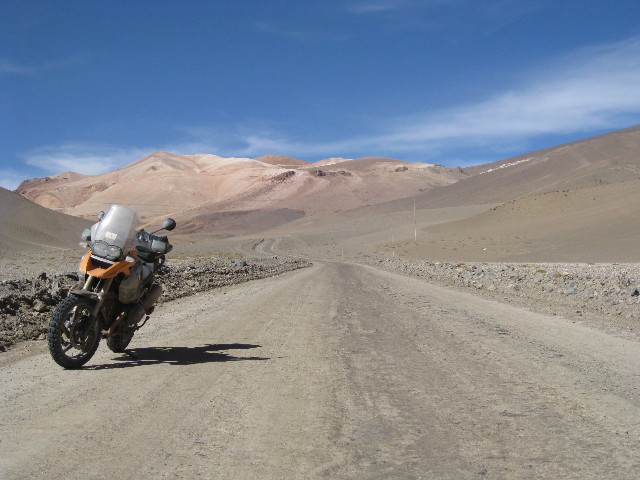
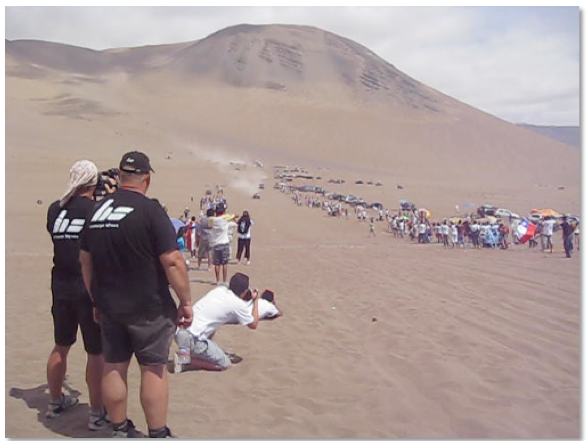
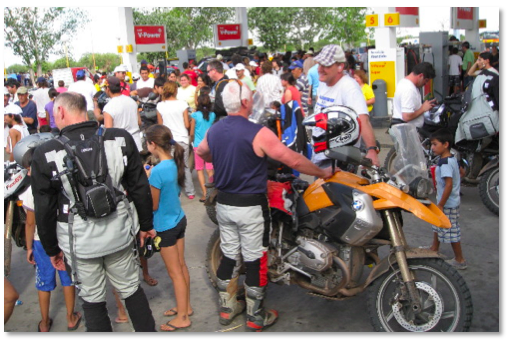
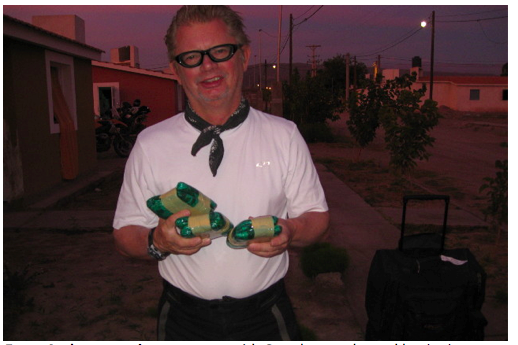
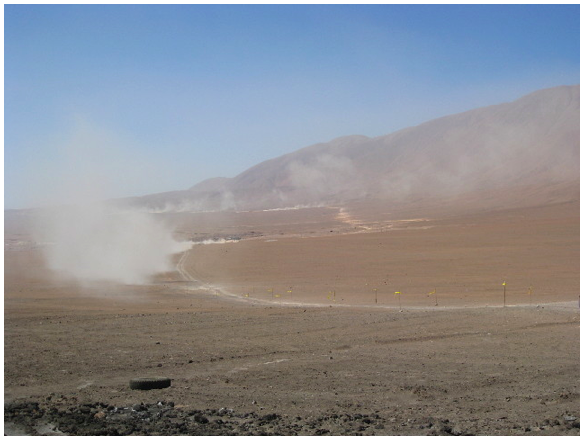
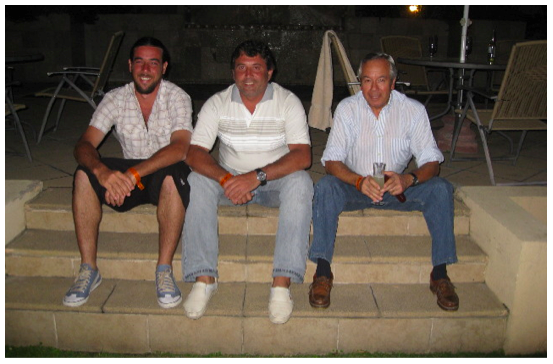
Quote of the trip? “Portuguese is going to be a REAL foreign language”….priceless. Just think, you could have saved an entire day if you’d read my U.S. State Dept. email about how to get from Bolivia to Brazil…but NOOOOOOOO, you wanted the “excitement” of not knowing what comes next. Well Adventure Travelers, you got it. Hilarious.
I expected to hear you cough as you passed the truck. Yes, rain would have made that 26 miles much different. You would have joined the other “campers.”
Need more of those photos of the beautiful kids.
How is it that you find a party where ever you go? When can we go on a trip together – sans motorcycle please?
We were very happy that you guys joined us at the party. We hope see you guys some day again
We will follow your trip around Brazil by the website and when you guys come to south please make a stop at Curitiba.
Will be a pleasure make a barbecue for both of you.
Take care and Keep in touch.
I can’t believe you said publicly, “Sam was right.”
Road conditions: Nice to see another set of riders still around! We’re heading into Bolivia in a couple days and would LOVE up to date info on road conditions around SW Bolivia inc. Salar.
Cheers,
Chris
Chris-
Reports on road conditions are only useful if they’re VERY current, especially in Bolivia, as conditions change daily/weekly. When we were in Ururo, the road to the Salar was closed to almost all traffic because of the huge rains. Days later I heard it was open to buses, etc.
KR scoured HUB and other sites looking for bikers a week or so ahead of us on the road. We found a couple which were useful.
BUT, I would ignore any road advice more than a week old and I would verify whatever I heard with local sources. There are lots and lots of rumors and warnings that proved to cause more worry than trouble in reality.
I can tell you that there is a 40 km stretch on Ruta 4 between Santa Cruz and the border that is dirt — and probably mud if it rains — that won’t be fixed anytime soon. This stretch literally connects the east and west parts of a wonderful highway. This dirt stretch is out in the middle of nowhere and shouldn’t be attempted if its been raining. Also, there is no gas near, so make sure you fill up whenever possible.
Fred